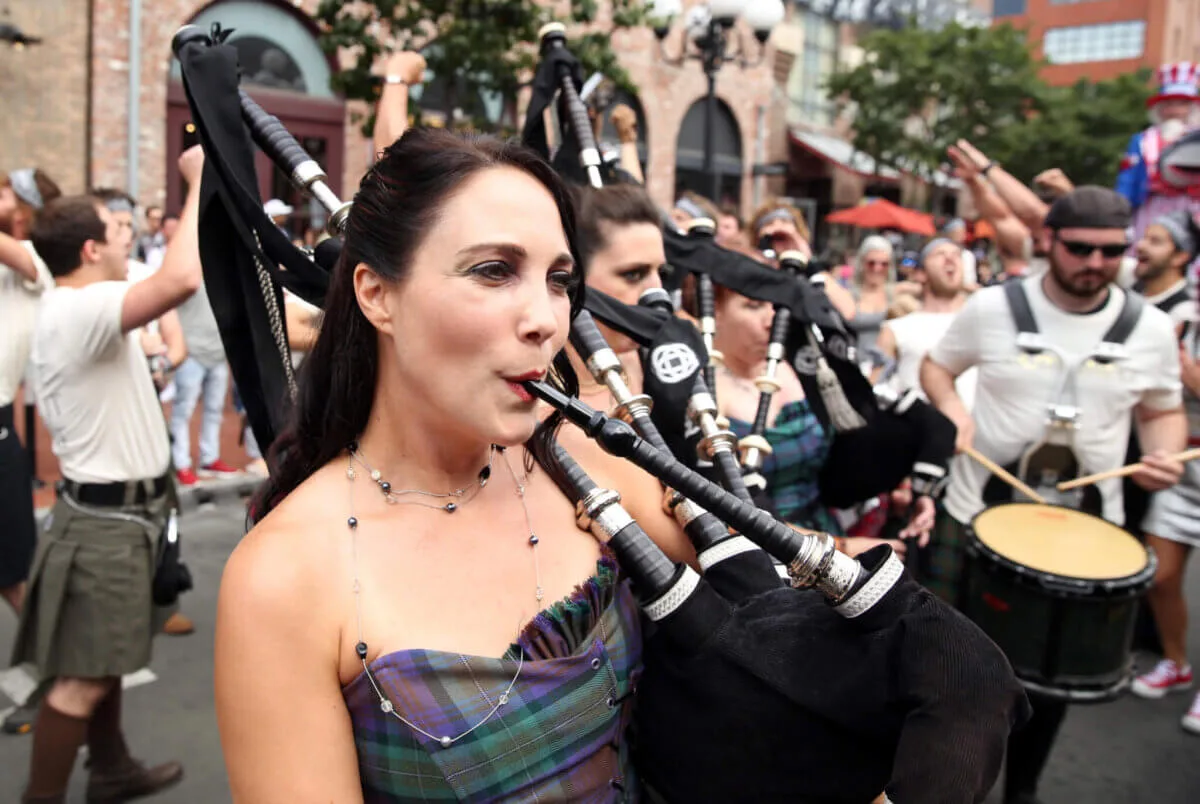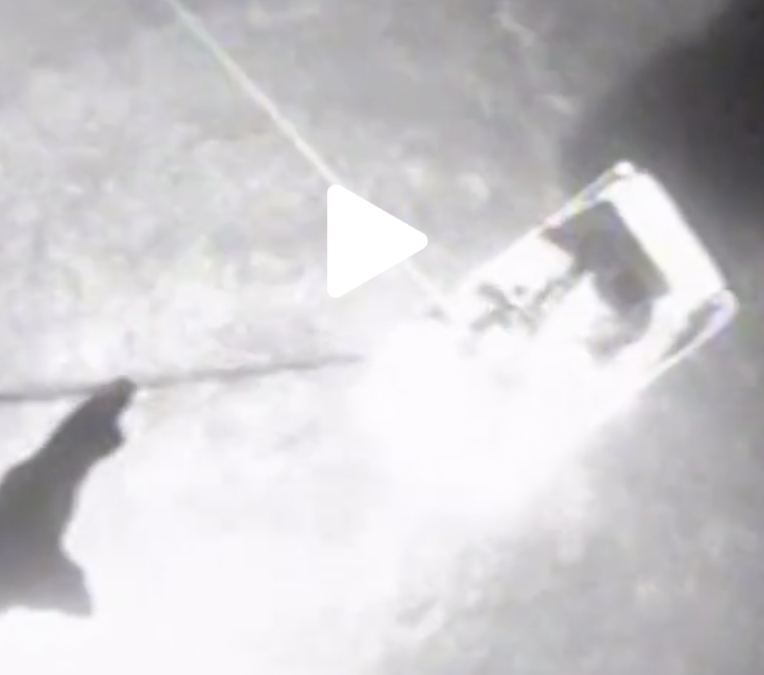
Bagpipers dressed as Highlanders promoting the STARZ original series "Outlander" are seen during San Diego Comic-Con in 2015. (Photo by Matt Sayles/Invision for STARZ/AP Images)
The popular fantasy romance series has spurred a lot of interest in our state’s Scottish ancestry. But some of it is just plain wrong.
Whether you are a North Carolinian of Scots-Irish descent, a bluegrass aficionado, or the word Sassenach makes you squeak, you probably already have an inkling that North Carolina (especially Western North Carolina) has deep ties with Scottish heritage.
For Daniel Williamson, head curator of the Scottish Tartans Museum and Heritage Center in Franklin, NC, sharing this heritage is more than a job (and it’s definitely not a high paying job)–it’s his calling.
There’s only one problem:
“Scotland is a place where people tell stories. And stories, often, are more popular than the facts. And I’m not mocking my ancestors or anything, that’s Scotland,” Williamson explains.
Between the Scots’ own embellishment (and Outlander, the mega-popular fantasy romance, cranking it up to an 11), there are quite a few misconceptions about Scottish history in North Carolina, not to mention the signature tartan cloth.
So, in addition to caring for the museum’s collection of rare tartans, Williamson spends a lot of his time re-educating, or as he puts it, “Trying to set people straight on things in the nicest way possible.”
Cardinal & Pine sat down with Williamson to discover some of the gems of the collection and set the record straight on these misconceptions:
Misconception 1: The best place to learn about tartan is Scotland.
These days, the only place in the world to visit a tartan museum is in the town of Franklin, NC. The museum was originally started as the American outpost of the Scottish Tartans museum in Pitlochry, Scotland in 1988 by the late Dr. Gordon Teall, Laird of Teallach and the chairman of the Scottish Tartans Society. But the Pitlochry museum closed down almost twenty years ago.
Why Franklin, NC (population 4,241)?
Is it because North Carolina has the largest population of Scottish descent outside of Ireland? Nope. That’s California.
Rather, Teall enjoyed bluegrass festivals in the area and the town is approximately the midpoint between the two largest Highland Festivals in the United States: Stone Mountain, Georgia and Grandfather Mountain, NC.
Misconception 2: Scottish immigrants originally moved to the Blue Ridge Mountain area because the view reminded them of Scotland.
While Blowing Rock, NC may or may not be painting a mural of Jamie Fraser’s /Sam Heughan’s jawline funded by a portion of their revived tourism revenue, Jamie Fraser and his real-life counterparts would have been much more likely to settle in Pennsylvania than the Blue Ridge Mountains.
Most Scottish immigrants who moved to NC had already been in America for over 150 years and their ancestors were actually from Lowland Scotland, “You’re talking about their great, great, great grandparents–they had no idea what Scotland even looked like,” Williamson explains. The main motivation was free and cheap land.
Instead of Highlander culture, what these immigrants of Scottish descent brought with them were cultural practices–like bluegrass music–and nicknames: “Redneck was a derogatory term for the Irish in lowland Scotland–because the Irish used to wear red scarfs. The Irish would call the Scotts Redshanks because of their height and hairy red legs,” Williamson shares.
Wherein we discover the kernel of truth behind all of Outlander: Jamie’s leg hair.
Misconception 3: Family tartans date back to ancient times.
Not quite. The earliest tartans in Scotland (from the end of the 16th century and beyond) were made by a local weaver, using whatever dyes were accessible: either natural dyes from regional plants or commercial dyes if she lived near a port. Attributing clan names to tartan patterns didn’t begin until the 19th century as a marketing tactic by commercial woolen mills–sorry season 1, episode 7.
The museum does have some tartan that predates the commercial era. A treasure of the collection is a fragment of red tartan from approximately 1725 donated by the Scottish Tartans Society. However, many of the textiles in the collection were passed down by local families for generations.
Misconception 4: The oldest tartan is the most valuable.
No. That would be space tartan.
Astronaut Alan Bean brought pieces of MacBean tartan with him on the Apollo 12 mission in 1969 (though unfortunately he didn’t have them on him during his moonwalk). Later, Jerry Ross, the joint record holder for most space missions, brought the Ross Hunting and Ross Red tartans with him.
Portions of all of these tartans are on view at the museum and are their most prized possessions.
Misconception 5: The pleats go in the front.
Contemporary tartan kilts (some Hollywood portrayals) locate the pleats at the front, but in the past, pleats were located “over the buttocks.” Williamson admits that Outlander at least got this one right.
Throughout history the pleating pattern has evolved from the box pleat (cheerleader skirt) pre-1850 to the knife edge pleat (accordion) post-1850. The museum’s Kingussie kilt, sewn between 1830-40, is one of two kilts remaining in the entire world that have a combination of the two types of pleating from this transitional period.
Misconception 6: The tartan ban.
In 1746, after the British Crown had quashed the Jacobite rebellion, they passed the Act of Proscription that disarmed, and (as is most often recounted) prohibited tartan until its dissolution, 37 years later.
But Williamson explains that the ban was not quite as widespread or severe as a certain fictional Fraser would have you believe. “If you read the act, it only outlaws hyper-targeted clothing. Only men were cited in the prohibition. Women and children still wore tartan, and some towns in Scotland were able to overturn the ban independently,” Williamson explains.
Misconception 7: ‘Outlander’ is the bane of Curator Daniel Williamson’s existence.
Williamson isn’t ready to completely dis the series, despite the vast anachronisms and embellishments: “ Honestly, it has actually sparked a lot of people’s interest, which is good.”
Not only has Outlander performed wonders in the museum’s gift-shop, but it’s brought new people into the museum to learn the real story.
Politics

VIDEO: Senate Republicans Block Bill to Extend Child Tax Credit
View this post on Instagram A post shared by Cardinal & Pine (@cardinalandpine) Monday was tax day, and Senate Republicans are...

NC’s Congressional Democrats urge House to protect IVF
Any Republican serious about protecting IVF needs to put their votes where their mouth is, the Democrats wrote to House leadership. After the...
Local News

The zodiac signs of 12 iconic women offer insight into their historic accomplishments
Zodiac signs can tell you a lot about someone’s personality. Whether they’re an earth, water, air, or fire sign, these 12 categories (which are...

VIDEO: Two men rescued off Beaufort, NC
https://www.tiktok.com/@cardinalandpine/video/7353300192906562859?lang=en WATCH: We love our Coasties in NC! ⚓️ When a boat ran aground off of...




